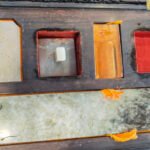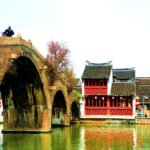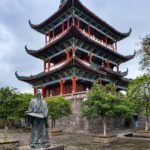Fangfeng Mountain, located on the north bank of Xiazhuhu Lake, is only 125 meters above sea level. It starts from Guanyinling in the east, connects Maotianfan in the west, reaches Zifu Temple in the north, and Erdu market town is on its southern slope. Fangfeng Mountain is also known as Fengshan Mountain, Fengshan Mountain, and Fengzhushan Mountain. In the sixth year of Tianbao in the Tang Dynasty (747), it was renamed Fangfeng Mountain.

After bypassing the Fangfeng Temple and climbing up hundreds of steps along the stone steps, there is a flat area. In the past, it was a Taoist temple. Now only some walls remain. There used to be buildings such as ‘Guanyin Pavilion’ and ‘Listening to the Rain Tower’ here, which is called ‘Guanyinling’. ‘Listening to the Rain Tower’ is built along the mountain rock. Surrounded by green bamboo, it is quiet and simple.
On Guanyinling, there used to be ancient plum trees everywhere. In particular, there are many precious ancient plum trees. It is an important scenic spot on Fangfeng Mountain (ancient plum scenery). There used to be the saying of ‘ten scenic spots on Fengshan Mountain’: ancient Fangfeng stele, listening to the rain in the bamboo forest, ancient plum scenery, Fengshan stone chamber, hundred-meter-deep pool, traces of Old Man Pan, overlooking from the morning sun, spring shoal waves, rosy clouds and flying rainbows, and strange pines waiting for cranes. As time passes, some scenic spots no longer exist.
Going up along the stone steps, there is a Bat Zen Temple. Looking into the distance from a high place, you can see the sparkling Xiazhuhu Lake. Large and small river ports and farmlands are interspersed with each other. The land and water areas are roughly equal, fifty-fifty. It has a typical taste of Jiangnan water town, which is refreshing. If you watch the sunrise in the early morning and bathe in the fairyland of thousands of rays of morning glow and mist, you are a blessed person. ‘Overlooking from the morning sun’ is truly worthy of its reputation.
To the north of Bat Zen Temple is the magical scenic spot of ‘Fengshan Stone Chamber’, commonly known as ‘Bat Cave’ and elegantly named ‘Fenggong Cave’. In ‘Shan Hai Jing’, it is called ‘the hall of great men’. It is cool in summer. The cave seeps water all year round. People enter without sweating. According to ‘Wukang County Annals’ of the Daoguang period, ‘the cave can hold a hundred tables’. It is astonishing. It is said to be the residence of the king of Fangfeng Mountain. The entrance of the cave is tall and spacious. The cave wall drips water. The water quality is cool and sweet. Drinking it often can lead to a long life.
On the cliff on the east side of the stone cave, the cliff inscriptions can be clearly distinguished, including ‘Wei Lanlai’, ‘Enjoying the scenery in leisure time’, ‘a haven of peace and happiness’, etc. It exudes a strong historical and cultural atmosphere. Fenggong Cave has a natural microclimate that is warm in winter and cool in summer, and there are no mosquitoes or flies. It is a great place to escape the heat and cool off. Its mystery has attracted many literati to visit.
Walking more than a hundred steps eastward out of the stone chamber, there is the scenic spot of ‘Dragon Pool’. The cliff stands perilously, and it is quiet and free from dust. It is also called ‘Renci Pool’. Its three sides are like steep walls. Standing alone on the south side, the water is deep and quiet, and it never dries up. It used to be the release pool of Chaoyang Zen Temple.
If you climb up along the stone steps again, you will enter the ‘Heavenly Chamber’. Sitting there quietly, you can have a panoramic view of the ancient country of Fangfeng. The lake, the sky, the green bamboo, the reed marshes, the black tiles and white walls, and the rural scenery are extremely beautiful.
On this Fengshan Mountain, there was a ‘Ten Thousand Volume Tower’ in the Ming Dynasty, known as ‘Ten Thousand Bamboo Mountain House’. There are five rooms in the tower and ten thousand volumes of books are collected. There are interesting words printed on the books, ‘Borrowing books is unfilial’, which makes people laugh.
Here, the peaks are steep and the rocks are jagged. There were originally seven towering ancient pine trees with crooked branches. Wild cranes would fly here to perch and gather from time to time. It got its name from the poem ‘Seven ancient pines await the return of cranes’. Now only one lone pine tree remains. Walking down the slope, there used to be the Dongyue Palace on Shengtang Ridge, which is a Taoist temple that worships truth. To the west is the ‘Sishui Nunnery’. Behind the nunnery, the stone wall is abrupt, and below it is a clear spring. These landscapes have all disappeared. But we can still see one of the ten scenic spots of Fengshan Mountain, the ‘Hundred-foot Deep Pool’. This pool is about one mu in size and unfathomably deep. It is surrounded by precipitous cliffs on three sides and is more than ten feet high. Looking down from the side of the cliff is thrilling. When the sun shines directly on the pool surface, if there is no wind, the swimming shadows can be clearly counted. Open all year round and all day.







